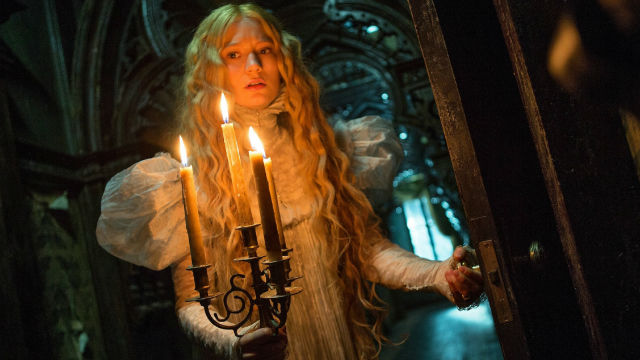Movie Review: Crimson Peak (2015)
“Beware”


Movie Review: Crimson Peak (2015)
Director: Guillermo del Toro
Cast: Mia Wasikowska, Jessica Chastain, Tom Hiddleston
Synopsis: An American heiress finds her life is in danger when she travels to England with her new husband and his sister.
Life in late 19th Century New York is viewed through a golden-orange filter in Crimson Peak, a Gothic chiller from Guillermo Del Toro that draws upon influences as diverse as Hitchcock, Bava, Murnau and Kubrick to breathe life into a plot right out of the 1890s. In her semi-cloistered world, Edith Cushing (Mia Wasikowska) writes stories about ghosts in the very bedroom in which, as a child, she was visited by the spirit of her mother, who warned her to ‘beware of Crimson Peak.’ Those to whom she submits her manuscripts would prefer she write love stories, but Edith has no time for love – until, that is, she meets the dark but charming Sir Thomas Sharpe (Tom Hiddlestone – Midnight in Paris), an impoverished Englishman of title who is in New York hoping to secure finance from her father for his new mining invention. Edith’s father (Jim Beaver – Cooties) disapproves of Sharpe, but dies mysteriously of a crushed skull before he can put an end to the romance, and so Edith turns to Thomas for solace. Marriage is an inevitability, and Edith travels from New York with her new husband and his somewhat aloof sister, Lucille (Jessica Chastain – The Help, Interstellar), to Allerdale Hall, the family home on the Cumbrian Moors, where she finds a world far removed from her own. A once magnificent structure, the Sharpe house has fallen into disrepair since the family lost its wealth; a threadbare carpet of snow or leaves lies on the floor of the reception hall beneath a hole in the roof, shadows gather in the dimly lit corridors, and Edith is forbidden by Lucille from visiting many rooms because the floors are unsafe. In fact, as Edith grows weak from some mystery illness, Lucille grows increasingly controlling. Worse than all this, though, are the horrifying visions Edith has of spectres roaming the halls of the crumbling mansion.
Following the disastrous misstep that was Pacific Rim, Guillermo Del Toro applies his lush visual style to an old-fashioned tale that would more accurately be described as Gothic melodrama than horror, but which nevertheless marks a return to form for the man who gave us The Devil’s Backbone and Pan’s Labyrinth. Del Toro seems to see the world differently to the rest of us, as if filtered through a prism that renders the unremarkable remarkable, so that insignificant objects become instruments of menace or wonder. Allerdale Hall is a marvel of bleak imagination, a cold maze of dark, shadowy corridors, crooked walls and floors of deepest ebony. Vivid red clay from the ground into which the mansion is slowly sinking leeches through the floorboards like blood. Black moths adorn its posts and walls. Allerdale Hall is a house in its death throes, and is truly a marvel of set design without which Crimson Peak would be an anaemic shadow of what it is. Del Toro complements his story’s vintage influences by eschewing the conventions of the modern filmmaker and returning to the techniques of masters like Murnau and Hitchcock. There are no jump cuts, no rapid editing, no hyperactive camera, and a number of scenes end with an iris shot in which the image is reduced to a small circle surrounded by blackness, a device barely seen since silent days, but which perfectly symbolises the darkness that threatens to engulf Edith.
Crimson Peak’s plot could fall apart in the hands of a lesser director, but we’re so dazzled by Del Toro’s mastery of his craft that we fail to see the flaws in its internal logic until the credits have rolled. Edith is a beacon to those in the spirit world to whom she was close; twice she is visited, and yet the one spirit who could have prevented her from travelling to Crimson Peak – which, Edith discovers too late, is the name given by the locals to the hill upon which the Sharpe home precariously sits – fails to materialise, presumably because, if they were to do so, there would be no tale to tell. Sadly, having studiously avoided the conventions and pitfalls of the modern horror, Del Toro provides a depressingly orthodox resolution to his story, one found so regularly in a movie in which a woman is in peril that it’s difficult to understand how Del Toro could have opted for such a prosaic denouement . Overall, though, Crimson Peak is a satisfying enough watch, and a respectable addition to Del Toro’s back-catalogue.
(Reviewed 6th July 2016)
httpv://www.youtube.com/watch?v=6yAbFYbi8XU


0 Comments